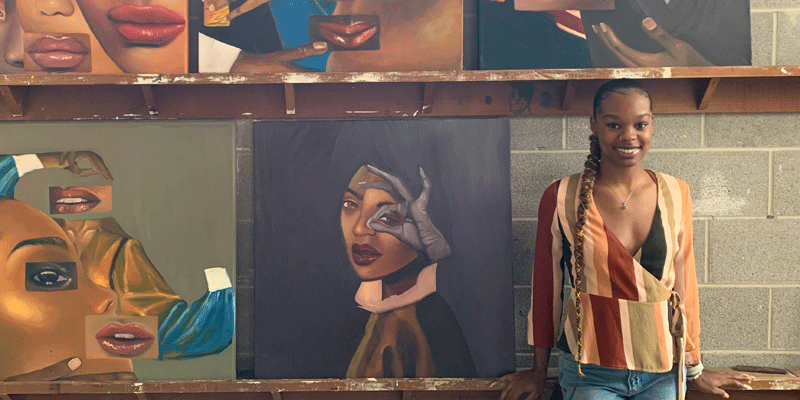Chalara Sutton, ’21, Creates ‘Distinctively Black’ FURSCA Art Project
December 22, 2020
By Jake Weber

Chalara Sutton, ’21, stands with some of her works in the Bobbitt Visual Arts Center painting studio. Sutton is a studio art major from Euclid, Ohio.
The talented and imaginative Chalara Sutton, ’21, would be the first to tell you that being an artist is about much more than, well, being talented and creative. With the support of an Albion College FURSCA grant, Sutton spent this past summer focused on her art series, “Distinctively Black,” and discovered that a lot of the work didn’t involve paints or a brush.
“I thought I was ready to create something that Black women could really relate to,” says Sutton, recalling her initial plans for the project. “My adviser (professor of art Michael Dixon) kept telling me, ‘Dig deeper, dig deeper.’ I had to really look at my own story and it was difficult to explore some very personal ideas. But once I started telling my story, I found out it was a way for people to understand that they’re not the only ones going through the same struggles. I am breaking free from society’s norms and finding my own identity as a Black woman through my collages and paintings. I hope I can inspire Black women like me to do the same.”
Sutton’s series of oil paintings explore what she experienced as almost two childhoods. After spending her early years in a predominantly white community, Sutton and her family moved to a predominantly African American community where she attended high school.
“I could never really fit in with white groups or Black groups,” she says, noting for example that her hair was seen as problematic by both groups. “I started straightening my hair because it was so big and noticeable and I wanted to fit in,” she says. “Then when I moved, people were making comments that I was white because I have straight long hair.”
In exploring ways to present her identity within a larger conversation about “how Black women are supposed to look,” Sutton developed her unique “collage painting” approach. Each painting begins as a collage of images cut from magazines, advertisements and other printed materials. Once the collage is finished, Sutton uses it as the model for an eventual, much larger, painting.
“Just creating the collages is a challenge, because magazines aren’t easy to find,” she says, especially for an artist whose focus is on people of color. Thrift stores are where Sutton finds most of her collection of old Ebony and Essence magazines, some of which date to the 1960s.
The work would seem to be a contradiction—autobiographical and deeply personal, while including almost no images of Sutton herself. She notes, however, that using these idealized images highlights many contradictions felt by Black women.
“The images aren’t me but they represent me, and they’re broken up to represent how out of place I feel in this society,” Sutton explains. “Black women haven’t always been represented as beautiful. I arrange my images to show that Black women have power through these features.”
“This makes a story with a different narrative.”